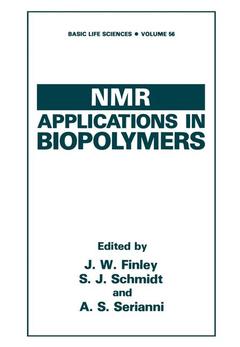Description
NMR Applications in Biopolymers, 1990
Basic Life Sciences Series, Vol. 56
Coordinators: Finley John W., Schmidt Siegfried J., Serianni A.S.
Language: English
Subjects for NMR Applications in Biopolymers:
Publication date: 03-2012
526 p. · 17.8x25.4 cm · Paperback
526 p. · 17.8x25.4 cm · Paperback
Description
/li>Contents
/li>
Elucidating the structures of biopolymers as they exist in nature has long been a goal of biochemists and biologists. Understanding how these substances interact with themselves, other solutes, and solvents can provide useful insights into many areas of biochemistry, agriculture, food science and medicine. Knowledge of the structure of a protein or complex carbohydrate in its native form provides guidelines for the chemical or genetic modifications often desired to optimize these compounds to specific needs and applications. For example, in the pharmaceutical industry, structure-function relationships involving biopolymers are studied rou tinely as a means to design new drugs and improve their efficacies. The tools to conduct structure investigations of biopolymers at the molecular level are limited in number. Historically X-ray crystallography has been the most attractive method to conduct studies of this type. How ever, X-ray methods can only be applied to highly ordered, crystalline materials, thus obviating studies of solution dynamics that are often critical to attaining a global understanding of biopolymer behavior. In recent years, nuclear magnetic resonance (NMR) spectroscopy has evolved to become a powerful tool to probe the structures of biopolymers in solution and in the solid state. NMR provides a means to study the dynamics of polymers in solution, and to examine the effects of solute, solvent and' other factors~n polymer behavior. With the development of 2D and 3D forms of NMR spectroscopy, it is now possible to assess the solution conforma tions of small proteins, oligonucleotides and oligosaccharides.
Applications of NMR in Agriculture and Biochemistry.- Carbohydrate Stereochemistry, and NMR Spectroscopy.- Applications of 2D NMR Spectroscopy to Carbohydrates.- Two-Dimensional NMR Spectrum Editing of Carbohydrates.- Determination of Complex Carbohydrate Structure Using Carbonyl Carbon Resonances of Peracetylated Derivatives.- Selective Excitation Techniques for Water Suppression in One-and Two-Dimensional NMR Spectroscopy.- Oxygen Exchange and Bond Cleavage Reactions of Carbohydrates Studied Using the 180 Isotope Shift in 13C NMR Spectroscopy.- Computer-Aided Conformational Analysis Based on NOESY Signal Intensities.- Determination of DNA and Protein Structures in Solution Via Complete Relaxation Matrix Analysis of 2D NOE Spectra.- The Structure and Behavior of the Starch Granule as Studied by NMR.- Water Interactions in Bovine Casein: 2H NMR Relaxation and Small-Angle X-Ray Scattering Studies.- Carbon-13 NMR Studies of Native, Gelled, Heat- and Chemically-Denatured Soy Glycinin and ?-Conglycinin at Neutral pH.- NMR Studies of the Structure and Environment of the Milk Protein ?-Lactalbumin.- Applications of Multinuclear NMR in the Solid State to Structural and Dynamical Problems in Macromolecular Chemistry.- Heterogeneity of Intact Collagen by Solid State Multinuclear Magnetic Resonance.- Forage Digestibility and Carbon-13 Solid State NMR.- NMR of Carbohydrates at the Surface of Cells.- Studies of Evolving Carbohydrate Metabolisminvivo by 13C Surface-Coil NMR Spectroscopy.- Uptake, Metabolism, and Storage of Phosphate and Nitrogen in Plant Cells; an NMR Perspective.- In Vivo Phosphorus NMR Studies of the Hepatic Metabolism of Amino Sugars.- Multinuclear Spin Relaxation and High-Resolution Nuclear Magnetic Resonance Studies of Food Proteins, Agriculturally Important Materials and Related Systems.- 1 H and 2 H NMR Studies of Water in Work-Free Wheat Flour Doughs.- Characterization of Water in Foods by NMR.- Use of 13C and 170 NMR to Study Wheat Starch-Water-Sugar Interactions with Increasing Temperatures.- Application of the Low Resolution Pulsed NMR “Minispec” to Analytical Problems in the Food and Agriculture Industries.- Automatic Use of Small Nuclear Magnetic Resonance Spectrometers for Quality Control Measurements.
© 2024 LAVOISIER S.A.S.




